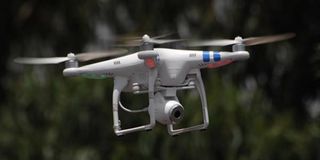Government bans drone use to fight poaching in Ol Pejeta

A drone is used to record Catholic faithful during the Way of the Cross ceremony. Nairobi has lately been invaded by internationally acclaimed televangelists and sundry local men of God keen to keep the flock on the straight and narrow. PHOTO | SALATON NJAU | NATION MEDIA GROUP
What you need to know:
- Ol Pejeta had planned to launch the drone in June after successfully testing a model drone by the US based manufacturer Airware
- The drone was released for a two week trial run at Ol Pejeta Wildlife Conservancy ahead of its launch
Plans to launch a wildlife surveillance drone at Ol Pejeta Conservancy in June suffered a major setback after the government banned it over security concerns.
Ol Pejeta Conservancy’s Chief Commercial Officer Mr Robert Breare and Public relations Manager Ms Elodie Sampere said the plan to launch the pilotless drone dubbed the ‘aerial ranger’ to enhance protection of wildlife has been stopped due to rising insecurity.
“One of the things that has now arisen is that the Kenya Government have put a ban in place on private sector drones for the time being. We will be working closely with the Kenya Wildlife Service (KWS) to identify the way forward for our conservation drone but in the meantime we ask you to continue your incredible patience as we work to bring this project to fruition” they said in a joint statement.
Ol Pejeta had planned to launch the drone in June after successfully testing a model drone by the US based manufacturer Airware.
Apart from surveillance, the drone would have seen Kenya launch its first virtual tourism village to be beamed real-time to classes, colleges and other forums via the internet.
The drone was released for a two week trial run at Ol Pejeta Wildlife Conservancy ahead of its launch.
Early in the year, Ol Pejeta received approvals to launch the drone from relevant agencies in the government and a two week test-drive conducted successfully for the two kilogram Unmanned Aerial Vehicle (UAV).
“To avoid the need for Ol Pejeta to employ full time pilots and engineers, Airware has developed a simple digital mapping interface, meaning that even a technophobe with no pilot training should be able to control the drone from the ground station.
“While the sensors are tweaked, the screws tightened and the wires adjusted, wildlife conservationists everywhere can prepare themselves for a revolution,” said Ms Sampere.
Drones are mainly used for military purposes, bombing enemy zones and suspected terrorist sites but of late, UAVs have been deployed for use in peaceful purposes such as security surveillance within posh homes, wildlife sanctuaries and in large industrial firms.
“From surveying oil pipelines, to searching for missing persons, to an online retail giant announcing an unconventional new delivery system - the drone is being demilitarised and is finding employment in more overt sectors. There are countless everyday challenges that could be more easily solved with an unmanned aerial vehicle (UAV).
“The entire operation could then be commandeered from the air directing security officers on foot. While it gross reduces costs of patrolling the 52,000 acre conservancy, the images recorded could also be produced in court as evidence against suspected poachers upon arrest. The deterrent factor alone could have a significant impact on poaching incidents,” said the statement from Ol Pejeta.
The idea to launch a pilotless drone was mooted a year ago and about Sh3 million raised via crowd funding platform where wildlife lovers across the world contributed cash for it.
The move followed rise in cases of peaching of elephants and rhinos. Last year Kenya witnessed the loss of 50 rhino to poachers.
Ms Sampere said the drone once launched would also reduce costs of conducting wildlife census across its vast land area where a light aircraft is hired at Sh18,920 ($220) per hour for 13 hours, with the data collected being subjected to a large degree of human error as counting has to be done in real time and with wide transects.





